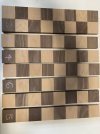Hi All,
My table saw has been collecting dust for too long and I'm looking forward to using it regularly. I've spent the last month or so cleaning up my garage so now I have a good size area to work in. My son is really into chess and we've made a board (purpleheart / alder) and now he wants to turn his own chess pieces. I've realized that even with a planer I'm awful at gluing up boards. We have a second board in the works (walnut / alder) and had to walk away from our last glue attempt. I'm hopeful that we can salvage it (though it's the crosscuts that we're gluing up so a bit more difficult for me anyway).
Hope to gain some valuable insights here and learn a few things.
Nice to meet all of you!
My table saw has been collecting dust for too long and I'm looking forward to using it regularly. I've spent the last month or so cleaning up my garage so now I have a good size area to work in. My son is really into chess and we've made a board (purpleheart / alder) and now he wants to turn his own chess pieces. I've realized that even with a planer I'm awful at gluing up boards. We have a second board in the works (walnut / alder) and had to walk away from our last glue attempt. I'm hopeful that we can salvage it (though it's the crosscuts that we're gluing up so a bit more difficult for me anyway).
Hope to gain some valuable insights here and learn a few things.
Nice to meet all of you!


